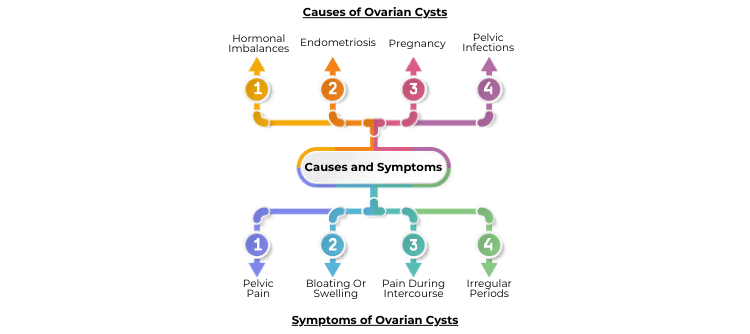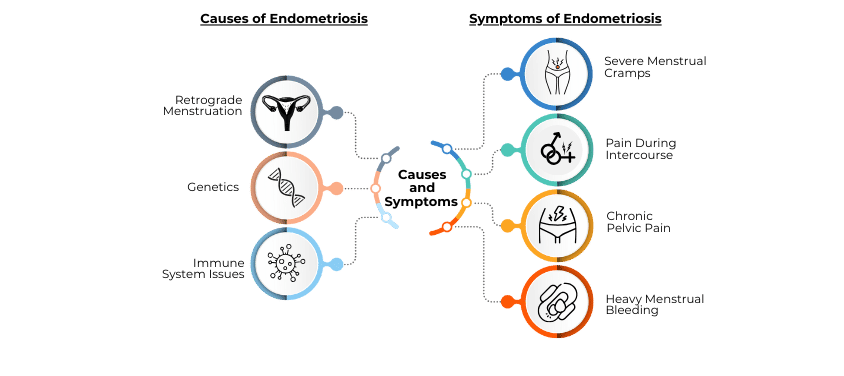
29 Oct What Are Ovarian Cysts And Endometriosis?
Ovarian cysts and endometriosis are two common conditions that can affect a woman’s reproductive health. Although they are distinct issues, both can cause pelvic pain and other symptoms that impact daily life. In this blog, we’ll explore what these conditions are, how they differ, and what treatments are available.
What Are Ovarian Cysts?
An ovarian cyst is a sac filled with fluid that forms either on or within an ovary. Most ovarian cysts are benign and disappear on their own without treatment. However, some cysts can grow large, rupture, or cause discomfort.
Ovarian cysts are generally classified into two main types:
1. Functional Cysts: These are the most common type and occur as part of the normal menstrual cycle. There are two subtypes:
◦ Follicular cysts, which form when the follicle fails to release an egg.
◦ Corpus luteum cysts, which develop after the egg is released and the follicle fills with fluid.
2. Pathological Cysts: These cysts are less common and can sometimes be cancerous. Some types include dermoid cysts (containing tissues like hair or teeth) and cystadenomas (filled with mucous or watery fluid).
Causes and Symptoms of Ovarian Cysts

Various factors can lead to the formation of ovarian cysts, such as:
• Hormonal imbalances
• Endometriosis (when endometrial tissue grows on the ovaries)
• Pregnancy
• Pelvic infections
In many cases, ovarian cysts don’t cause symptoms. However, larger cysts may lead to:
• Pelvic pain, typically occurring on one side
• Bloating or swelling
• Pain during intercourse
• Irregular periods
In rare cases, a cyst can rupture or cause the ovary to twist, leading to severe pain and the need for emergency medical care.
What Is Endometriosis?
Endometriosis is a chronic condition in which tissue similar to the lining of the uterus (endometrium) grows outside the uterus, often affecting the ovaries, fallopian tubes, and pelvic lining. This tissue behaves like normal endometrial tissue—it thickens, breaks down, and bleeds during each menstrual cycle—but because it’s outside the uterus, it has no way to exit the body. This leads to inflammation, scarring, and the formation of adhesions (bands of scar tissue).
Endometriosis affects an estimated 10% of women of reproductive age and can cause a wide range of symptoms.
You may also like: Earlier Detection of PCOS For Fertility Preservation: A Crucial Step Towards Parenthood
Causes and Symptoms of Endometriosis

The exact cause of endometriosis is not known, but several factors are believed to contribute to its development:
• Retrograde menstruation, which occurs when menstrual blood flows backward into the pelvic cavity.
• Genetics, as women with a family history of endometriosis are at higher risk.
• Immune system issues, which may prevent the body from clearing away endometrial-like tissue.
Symptoms of endometriosis can differ, but the most common ones include:
• Severe menstrual cramps and pain before or during periods
• Pain during intercourse
• Chronic pelvic pain
• Heavy menstrual bleeding
• Infertility
Differences Between Ovarian Cysts and Endometriosis
While both conditions involve the ovaries and can cause pelvic pain, they are different in their causes and impact on reproductive health:
• Ovarian cysts are often linked to hormonal imbalances or ovulation issues, whereas endometriosis is caused by the growth of uterine-like tissue outside the uterus.
• Most ovarian cysts are harmless and go away on their own, while endometriosis is a chronic condition that can lead to complications like infertility.
• Endometriosis pain tends to be more chronic and related to the menstrual cycle, while cyst-related pain may be acute if a cyst grows large or ruptures.
Diagnosis and Treatment
Both ovarian cysts and endometriosis can be diagnosed through pelvic exams, ultrasounds, and in the case of endometriosis, laparoscopy (a minimally invasive surgical procedure to examine the pelvic organs).
Treatment for ovarian cysts typically involves watchful waiting or, in some cases, surgery to remove larger or problematic cysts. Hormonal birth control may also be prescribed to prevent new cysts from forming.
Treatment for endometriosis focuses on managing symptoms, often through hormonal therapies like birth control pills or gonadotropin-releasing hormone (GnRH) agonists. In severe cases, surgery may be necessary to remove endometrial tissue and adhesions.
At Veramed Fertility and IVF Center, we offer hope through exceptional care and expert specialists. Our comprehensive services address a wide range of fertility challenges, and with state-of-the-art facilities and personalized treatment plans, we are a trusted partner for those embarking on their path to parenthood.
Conclusion
Both ovarian cysts and endometriosis can have a significant impact on a woman’s health and fertility. While ovarian cysts often resolve without treatment, endometriosis is a chronic condition that requires ongoing management. If you’re experiencing symptoms of either condition, it’s important to consult a healthcare provider for a proper diagnosis and treatment plan.

Sorry, the comment form is closed at this time.